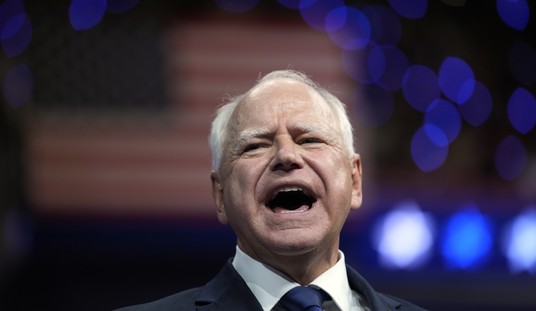It seems that Bloomberg has picked up where Reuters left off in reporting on jobs figures. The Department of Labor issued its normal weekly report on initial jobless claims, which had both an expected but slight rise in the number of claims reported last week — and an upward revision to the supposedly-improved position from the week before. In other words, especially after this week’s retail sales figures and last Friday’s jobs report for May, this should come as no surprise to anyone:
In the week ending June 9, the advance figure for seasonally adjusted initial claims was 386,000, an increase of 6,000 from the previous week’s revised figure of 380,000. The 4-week moving average was 382,000, an increase of 3,500 from the previous week’s revised average of 378,500.
The advance seasonally adjusted insured unemployment rate was 2.6 percent for the week ending June 2, unchanged from the prior week’s unrevised rate.
The advance number for seasonally adjusted insured unemployment during the week ending June 2 was 3,278,000, a decrease of 33,000 from the preceding week’s revised level of 3,311,000. The 4-week moving average was 3,281,500, a decrease of 2,500 from the preceding week’s revised average of 3,284,000.
What is this, the 66th week out 67th that the DoL has upwardly-revised the previous week’s figures? That’s hardly unexpected. An increase of 6,000 constitutes a rise of 1.6%, more or less statistical noise. The results fall squarely within the range we’ve seen most of this year, although it is getting to the upper band of that range, and inching closer to the 400K mark, a line that’s mainly important for political psychology.
That didn’t keep Bloomberg from breaking out the U-word in its headline and its report:
More Americans than forecast applied for unemployment insurance payments last week, another sign the labor market is struggling to improve.
Claims for jobless benefits unexpectedly climbed by 6,000 to 386,000 in the week ended June 9 from a revised 380,000 the prior week that was more than first estimated, Labor Departmentfigures showed today in Washington. Economists projected claims would fall to 375,000, according to the median estimate in a Bloomberg News survey.
A pickup in dismissals may raise concern the labor market will have trouble rebounding after a slowdown in job creation in the past four months. Weaker economic growth and a lack of clarity about the business environment may discourage companies from hiring at a pace needed to speed up the expansion.
Reuters went with the usual substitute, “more than expected” (via Steve Eggleston):
Consumer prices fell in May by the most in over three years as households paid less for gasoline, possibly giving the U.S. Federal Reserve more room to help an economy that is showing signs of weakening.
Jobless claims also rose more than expected, climbing to 386,000 for the week, while the current account deficit also expanded.
Oh, wait … there it is, six paragraphs down:
Meanwhile, the number of Americans filing new claims for unemployment benefits unexpectedly rose last week, government data on Thursday showed, suggesting persistent weakness in the labor market after stumbling badly in recent months.
Here’s my question: after two three straight weak-to-poor monthly job reports and a bad report on retail sales in May, on what basis did these economists expect an improvement? Of course, I’ve been asking that for a few years now, and it gets as much explanation as to why the DoL and BLS always have to make an upward revision on this series each week, when revisions should more or less even out between up and down over a significant period of time when the initial report relies on estimates. At this rate, though, the changes and the “unexpectedlys” aren’t helping the Obama administration any more, if they ever did.
Speaking of which, the Daily Caller takes a close look at Barack Obama’s nominee to run the Bureau of Labor Statistics, Erica Groshen. The BLS deals strictly in data and statistical analysis, which means that politics really shouldn’t enter into the appointment, and that the person should make all sides feel comfortable that the work within BLS will not get politicized, especially because their products are so crucial to informing public policy. Does Groshen’s background give a reasonable assurance that this will be the case? Er … perhaps not:
The president’s nominee to run the highly visible Bureau of Labor Statistics is on track to win Senate approval despite her ties to decidedly left-wing political groups, her critics say.
Erica Groshen’s left-wing ties include her 1998 co-authorship of an article urging an end to small businesses’ exemption from expensive federal regulations, and her husband’s 2011 donation to the far-left Working Families Party. …
Groshen co-authored her 1998 article, in which she argued against regulatory exemptions for small firms, for the union-backed Economic Policy Institute. That organization’s chief economist at the time, Jared Bernstein, later served as Chief Economist and Economic Adviser to Vice President Joe Biden.
“Large firms are doing well by employees, and themselves, by providing jobs with higher wages and benefits and greater job security,” read the article. “[P]ublic policy, rather than favoring small business by exempting it from many forms of regulation, should strive to be size neutral.”
The donation was $20, hardly a huge financial commitment to the left-wing group’s activities. Moreover, I don’t disagree that in principle regulation should be size-neutral. The problem is that even size-neutral regulation benefits larger players in markets, because they have economies of scale that allow them to absorb compliance costs without raising prices as much. That’s why larger companies will either tacitly support or actively lobby for regulation and licensing requirements, which handicap smaller firms and have the potential to drive them out of business. The short-term solution to this issue is to create sized-based exemptions, but the long-term solution is to sharply reduce regulation altogether to allow markets to find the winners and losers on their own.
Well-respected center-right economist Diana Furchtgott-Roth says that there isn’t anything to worry about, mainly because the person at the top can’t do anything to skew the data even if they wanted to — and Furchtgott-Roth doesn’t believe Groshen does:
“She’s a left-wing economist … but her public record is excellent — she hasn’t written anything weird,” said Diana Furchtgott-Roth, a senior fellow at the Manhattan Institute.
“She’s a very, very good economist and I don’t think there’s anything wrong with her,” Furchtgott-Roth said, adding that “no-one could be more Republican than I am.”
I hope she’s correct. I rely on BLS data for a lot of my analysis, and they have a very good reputation for getting things right — or at least as right as they can.








Join the conversation as a VIP Member